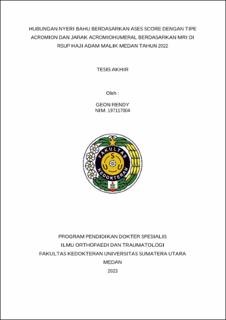| dc.description.abstract | INTRODUCTION
Rotator cuff tear (RCT) is the most common cause of pain and limited movement in the shoulder. Supraspinatus tear is the most common RCT with a prevalence of 61.9% in men and 38.1% in women over 60 years of age. Based on studies that have been carried out, there are several significant things that predispose to RCT and increase the degree of severity, including Lower lateral Acromial Angle (LAA), acromion morphology and acromiohumeral distance. The Society of the American Shoulder and Elbow Surgeons (ASES) is an assessment for shoulder and elbow disorders that is commonly used to evaluate pain and activity disorders that affect quality of life. This study aims to determine the relationship between shoulder pain based on ASES score and acromion morphology and acromiohumeral distance based on MRI examination at Haji Adam Malik Hospital in 2022.
METHOD
This research uses a cross-sectional descriptive analytical design. This research was conducted at HAM Hospital in 2022. The inclusion criteria for this study were all patients aged over 45 years who had a consultation at the Orthopedics and Traumatology clinic in 2022, experienced shoulder pain and had undergone an MRI examination procedure. Exclusion criteria included patients with a history of trauma to the shoulder and clavicle fracture. The normality test was carried out using the Shapiro Wilk test and the correlation test was carried out using the Spearman test and the significance of the results was expressed with a P value <0.05
RESULTS
In this study there were 38 patients who met the inclusion and exclusion criteria, with a distribution of male and female patients of 28.9% and 71.1%. The mean age of the patients was 54.66 ± 5.09 years, the acromion type included type I at 34.2%, type II at 2.7%, type III at 18.4% and type IV at 23.7%, the acromiohumeral distance was classified as narrow at 28.9%, normal 3.2 %, and wide 7.9%, and the average ASES score is 81.13 ± 12.38. In the correlation test between the ASES score and the acromiohumeral distance, the correlation results were moderate (r=0.387) and statistically significant (p<0.05). In the regression test, a coefficient of 5.85 was obtained, which means that increasing the acromiohumeral distance by 1 point will increase the ASES score by 5.85 points. In the correlation test between ASES score and acromion type, the results were not correlated (r=-1.81) and were not statistically significant (p=0.277).
CONCLUSION
There is a significant relationship between shoulder pain based on ASES score and acromiohumeral distance, however, there is no significant relationship between shoulder pain based on ASES score and variations in acromion type based on MRI examination. | en_US |


